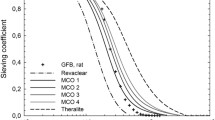Summary
The present study shows that liquid chromatography, especially as high performance size exclusion chromatography, is a useful tool to characterize newly developed highly permeable membranes, which are used for continuous arteriovenous hemofiltration (CAVH) of patients with renal failure. The molecular weight distribution in the ultrafiltrates of three hemofilters are compared using three different chromatographic systems. Especially in the region of the so-called “higher” molecular weight uremic toxins (MW above 2000 Dalton), the elution patterns of the filtrates show typical membrane-dependent differences. As we have shown earlier, the elimination of these higher molecular weight fractions might be of clinical relevance, as they contain inhibitors of DNA-synthesis in vitro.
Similar content being viewed by others
References
A.L. Babb, R.P. Popovich, T.G. Christopher, G.H. Scribner, The Genesis of the Square Meter-Hour Hypothesis, Trans. Am. Soc. artif. internal Organs17, 81–91 (1971).
A.L. Babb, P.C. Farrell, D.A. Uvelli, B.H. Scribner, Hemodialyzer evaluation by Examination of Solute Molecular Weight Spectra: Implications for the Square Meter-Hour Hypothesis, Trans. Am. Soc. artif. internal Organs18, 98–105 (1972).
J. Bergström, P. Fürst, Uraemic Toxins: inDrukker, Parsons, Maher, Replacement of renal function by dialysis, pp. 354–390, Nijhoff, Boston 1983).
H. Brunner, H. Mann, What Remains of the “Middle Molecule” Hypothesis today? Contr. Nephrol., vol.44, pp. 14–39 (Karger, Basel 1985).
H. Brunner, H. Mann, S. Stiller, H. -G. Sieberth, Permeability for Middle and Higher Molecular Weight Substances: Comparison between Polysulfone and Cuprophane Dialyzers, Contr. Nephrol., vol.46, pp. 33–42 (Karger, Basel 1985).
H. Brunner, H. Mann, Combination of Conventional and High-Performance Liquid Chromatographic Techniques for the Isolation of So-called “Uraemic Toxins”, J. Chromatogr.297, 405–416 (1984).
A.C. Schoots, F.E.P. Mikkers, H.A. Claessens, R. De Smet, N. Van Landschoot, S.M.G. Ringoil, Characterization of Uremic “Middle Molecular” Fractions by Gas Chromatography, Mass Spectrometry, Isotachophoresis, and Liquid Chromatography, Clin. Chem.28, 45–49 (1982).
Author information
Authors and Affiliations
Additional information
Supported by Deutsche Forschungsgemeinschaft (SFB 109/F5)
Rights and permissions
About this article
Cite this article
Brunner, H., Schäfer, U., Mann, H. et al. Molecular weight distribution in the ultrafiltrates of different filters used for continuous arteriovenous hemofiltration. Chromatographia 22, 399–403 (1986). https://doi.org/10.1007/BF02268798
Received:
Issue Date:
DOI: https://doi.org/10.1007/BF02268798




